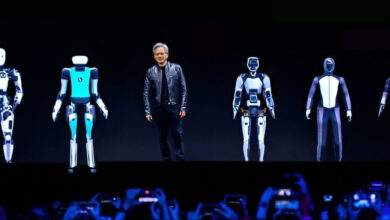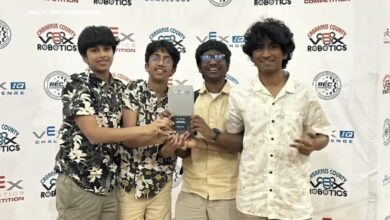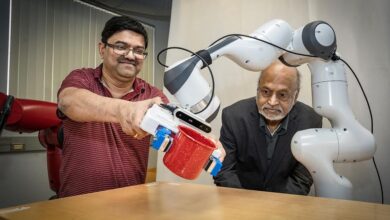Hello, Electric Atlas – IEEE Spectrum

Yesterday, Boston Dynamics bid farewell to the iconic Atlas humanoid robot. Or, the hydraulically-powered version of Atlas, anyway—if you read between the lines of the video description (or even just read the actual lines of the video description), it was pretty clear that although hydraulicAtlas was retiring, it wasn’t the end of the Atlas humanoid program at Boston Dynamics. In fact, Atlas is already back, and better than ever.
Today, Boston Dynamics is introducing a new version of Atlas that’s all-electric. It’s powered by batteries and electric actuators, no more messy hydraulics. It exceeds human performance in terms of both strength and flexibility. And for the first time, Boston Dynamics is calling this humanoid robot a product. We’ll take a look at everything that Boston Dynamics is announcing today, and have even more detail in this Q&A with Boston Dynamics CEO Robert Playter.
Boston Dynamics’ new electric humanoid has been simultaneously one of the worst and best kept secrets in robotics over the last year or so. What I mean is that it seemed obvious, or even inevitable, that Boston Dynamics would take the expertise in humanoids that it developed with Atlas and combine that with its experience productizing a fully electric system like Spot. But just because something seems inevitable doesn’t mean it actually is inevitable, and Boston Dynamics has done an admirable job of carrying on as normal while building a fully electric humanoid from scratch. And here it is:
It’s all new, it’s all electric, and some of those movements make me slightly uncomfortable (we’ll get into that in a bit). The blog post accompanying the video is sparse on technical detail, but let’s go through the most interesting parts:
A decade ago, we were one of the only companies putting real R&D effort into humanoid robots. Now the landscape in the robotics industry is very different.
In 2010, we took a look at all the humanoid robots then in existence. You could, I suppose, argue that Honda was putting real R&D effort into ASIMO back then, but yeah, pretty much all those other humanoid robots came from research rather than industry. Now, it feels like we’re up to our eyeballs in commercial humanoids, but over the past couple of years, as startups have appeared out of nowhere with brand new humanoid robots, Boston Dynamics (to most outward appearances) was just keepin’ on with that R&D. Today’s announcement certainly changes that.
We are confident in our plan to not just create an impressive R&D project, but to deliver a valuable solution. This journey will start with Hyundai—in addition to investing in us, the Hyundai team is building the next generation of automotive manufacturing capabilities, and it will serve as a perfect testing ground for new Atlas applications.
Boston Dynamics
This is a significant advantage for Boston Dynamics—through Hyundai, they can essentially be their own first customer for humanoid robots, offering an immediate use case in a very friendly transitional environment. Tesla has a similar advantage with Optimus, but Boston Dynamics also has experience sourcing and selling and supporting Spot, which are those business-y things that seem like they’re not the hard part until they turn out to actually be the hard part.
In the months and years ahead, we’re excited to show what the world’s most dynamic humanoid robot can really do—in the lab, in the factory, and in our lives.
World’s most dynamic humanoid, you say? Awesome! Prove it! On video! With outtakes!
The electric version of Atlas will be stronger, with a broader range of motion than any of our previous generations. For example, our last generation hydraulic Atlas (HD Atlas) could already lift and maneuver a wide variety of heavy, irregular objects; we are continuing to build on those existing capabilities and are exploring several new gripper variations to meet a diverse set of expected manipulation needs in customer environments.
Now we’re getting to the good bits. It’s especially notable here that the electric version of Atlas will be “stronger” than the previous hydraulic version, because for a long time hydraulics were really the only way to get the kind of explosively powerful repetitive dynamic motions that enabled Atlas to do jumps and flips. And the switch away from hydraulics enables that extra range of motion now that there aren’t hoses and stuff to deal with.
It’s also pretty clear that the new Atlas is built to continue the kind of work that hydraulic Atlas has been doing, manipulating big and heavy car parts. This is in sharp contrast to most other humanoid robots that we’ve seen, which have primarily focused on moving small objects or bins around in warehouse environments.
We are not just delivering industry-leading hardware. Some of our most exciting progress over the past couple of years has been in software. In addition to our decades of expertise in simulation and model predictive control, we have equipped our robots with new AI and machine learning tools, like reinforcement learning and computer vision to ensure they can operate and adapt efficiently to complex real-world situations.
This is all par for the course now, but it’s also not particularly meaningful without more information. “We will give our robots new capabilities through machine learning and AI” is what every humanoid robotics company (and most other robotics companies) are saying, but I’m not sure that we’re there yet, because there’s an “okay but how?” that needs to happen first. I’m not saying that it won’t happen, just pointing out that until it does happen, it hasn’t happened.
The humanoid form factor is a useful design for robots working in a world designed for people. However, that form factor doesn’t limit our vision of how a bipedal robot can move, what tools it needs to succeed, and how it can help people accomplish more.
Agility Robotics has a similar philosophy with Digit, which has a mostly humanoid form factor to operate in human environments but also uses a non-human leg design because Agility believes that it works better. Atlas is a bit more human-like with its overall design, but there are some striking differences, including both range of motion and the head, both of which we’ll be talking more about.
We designed the electric version of Atlas to be stronger, more dexterous, and more agile. Atlas may resemble a human form factor, but we are equipping the robot to move in the most efficient way possible to complete a task, rather than being constrained by a human range of motion. Atlas will move in ways that exceed human capabilities.
The introductory video with the new Atlas really punches you in the face with this: Atlas is not constrained by human range of motion and will leverage its extra degrees of freedom to operate faster and more efficiently, even if you personally might find some of those motions a little bit unsettling.
Boston Dynamics
Combining decades of practical experience with first principles thinking, we are confident in our ability to deliver a robot uniquely capable of tackling dull, dirty, and dangerous tasks in real applications.
As Marco Hutter pointed out, most commercial robots (humanoids included) are really only targeting tasks that are dull, because dull usually means repetitive, and robots are very good at repetitive. Dirty is a little more complicated, and dangerous is a lot more complicated than that. I appreciate that Boston Dynamics is targeting those other categories of tasks from the outset.
Commercialization takes great engineering, but it also takes patience, imagination, and collaboration. Boston Dynamics has proven that we can deliver the full package with both industry-leading robotics and a complete ecosystem of software, services, and support to make robotics useful in the real world.
There’s a lot more to building a successful robotics company than building a successful robot. Arguably, building a successful robot is not even the hardest part, long term. Having over 1500 Spot robots deployed with customers gives them a well-established product infrastructure baseline to expand from with the new Atlas.
Taking a step back, let’s consider the position that Boston Dynamics is in when it comes to the humanoid space right now.
The new Atlas appears to be a reasonably mature platform with explicit commercial potential, but it’s not yet clear if this particular version of Atlas is truly commercially viable, in terms of being manufacturable and supportable at scale—it’s Atlas 001, after all. There’s likely a huge amount of work that still needs to be done, but it’s a process that the company has already gone through with Spot. My guess is that Boston Dynamics has some catching up to do with respect to other humanoid companies that are already entering pilot projects.
In terms of capabilities, even though the new Atlas hardware is new, it’s not like Boston Dynamics is starting from scratch, since they’re already transferring skills from hydraulic Atlas onto the new platform. But, we haven’t seen the new Atlas doing any practical tasks yet, so it’s hard to tell how far along that is, and it would be premature to assume that hydraulic Atlas doing all kinds of amazing things in YouTube videos implies that electric Atlas can do similar things safely and reliably in a product context. There’s a gap there, possibly an enormous gap, and we’ll need to see more from the new Atlas to understand where it’s at.
And obviously, there’s a lot of competition in humanoids right now, although I’d like to think that the potential for practical humanoid robots to be useful in society is significant enough that there will be room for lots of different approaches. Boston Dynamics was very early to humanoids in general, but they’re somewhat late to this recent (and rather abrupt) humanoid commercialization push. This may not be a problem, especially if Atlas is targeting applications where its strength and flexibility sets it apart from other robots in the space, and if their depth of experience deploying commercial robotic platforms helps them to scale quickly.
Boston Dynamics
An electric Atlas may indeed have been inevitable, and it’s incredibly exciting to (finally!) see Boston Dynamics take this next step towards a commercial humanoid, which would deliver on more than a decade of ambition stretching back through the DARPA Robotics Challenge to PETMAN. We’ve been promised more manipulation footage soon, and Boston Dynamics expects that Atlas will be in the technology demonstration phase in Hyundai factories as early as next year.
We have a lot more questions, but we have a lot more answers, too: you’ll find a Q&A with Boston Dynamics CEO Robert Playter right here.
From Your Site Articles
Related Articles Around the Web



